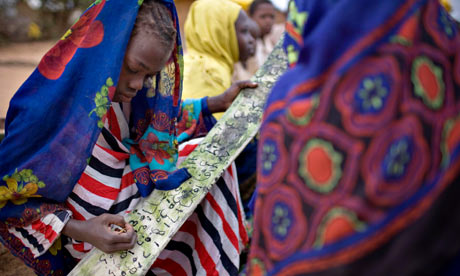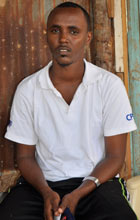New university campus near Dadaab complex aims to improve life for Somali refugees and prepare them for returning home
Clar Ni Chonghaile in Dadaab

A humble, green-roofed building on the outskirts of the world’s largest refugee settlement in north-eastern Kenya could be the unlikely portal that opens Ahmed Noor Hassan’s life, and the lives of thousands of other Somali refugees, to the world.
This is the proposed site for the Dadaab campus of Kenyatta University, the first higher-level institution to serve a refugee site. Classes, due to start in a few weeks, will include diploma, undergraduate and master’s courses in public policy, peace and conflict studies, commerce and education. They will be open to refugees, students from the local community and staff from humanitarian agencies.
“It will open the life of refugees to the external world,” says Noor Hassan, 25, a youth leader who is hanging out with friends in a small compound in Dagahaley, one of the five camps that make up the Dadaab refugee complex. “Our problems will be understood by the world.”

Ahmed Noor Hassan, 25, a youth leader at the Dagahaley camp in Dadaab, the world’s largest refugee complex, January 2013.
(Photograph: Clar Ni Chonghaile for the Guardian).
There is much to understand. In Dadaab, 448,000 refugees, mostly from Somalia, live in five giant camps in a sweltering, scrub-covered expanse of sand. Some camps have winding streets and trees, while the newest feature rows of tents housing people who fled Somalia’s famine in 2011. The idea of opening a university campus here is audacious – this corner of Kenya, just 90km (55 miles) from the border with Somalia, has been hit hard by years of war against the Islamic insurgents of al-Shabaab.
Improvised explosive devices have targeted police patrols in the camps, aid workers have been kidnapped, and several elders and community leaders have been shot. Foreign visitors must take a police escort to visit the site, and aid workers’ movements are restricted. Kenyan security forces have also been accused of abuses in the camps, after bomb attacks against them.
Noor Hassan wants to improve his skills so that when he goes home he can compete with Somali returnees from the US and Europe. He has applied to study public policy and administration at the new campus and although the fee of 100,000 shillings (£730) a year is high, he hopes he can raise it through savings and from friends living abroad.
The UN refugee agency, UNHCR, is seeking partners to provide scholarships to the new campus.
“If I finish, I will move to Somalia and take the risk, because no pain, no gain. If I stay here, I will be wasting my energy and my youth,” Noor Hassan says. “Let me have four more years of difficulty, then I can go there.”
Marangu Njogu, executive director of the Windle Trust, helped mobilise support for the Dadaab campus. Known as “the father of education” in Dadaab, he is a key player in the Borderless Higher Education for Refugees (Bher) project, a partnership between Canadian and Kenyan institutions aimed at improving education opportunities for refugees and marginalised local communities.
The Kenyatta University campus will “act as a launchpad [for Bher] to provide education for the refugees”, he says, arguing that education is as essential as emergency services. “When people look at refugees coming, and say, ‘We can’t do education because it’s an emergency’, it’s a disservice to the people … Education is the most critical element in helping human beings to develop and be self-reliant,” he says.
“We should provide education immediately, give people skills to be able to be in charge of their lives, and give them opportunities to interact with other people instead of just bundling them together,” Njogu says, adding that education also prevents young people from engaging in “antisocial activities”.
Programme development manager Tom Oindo says Windle Trust aims to improve life in the camps but also to prepare people for returning home. The organisation places a special emphasis on enabling girls to further their education. “We try to give a transformative education to ensure that we are actually equipping our scholars with skills to be able to contribute to the development of their home countries but, at the same time, have requisite skills to survive within the current situation.”
This idea underlies the Bher programme, which will provide a wide range of courses to refugees through a mix of online and on site resources, says Professor Wenona Giles of York University in Toronto, one of Bher’s lead partners.
Bher will not charge tuition fees, but will need contributions to cover direct costs. The consortium – including York University, Kenyatta University, the University of British Columbia and Kenya’s Moi University – wants to set up a fund to help refugees with transport, food and other expenses.
“This is a pilot project from which we can learn in order to do this in other sites,” says Giles. “Education is a right. And higher education should be a right. We’re looking at [using] phones, radios, MP3 players. We are going to use everything we can.” The Bher project will also have a learning centre on the Dadaab campus.
Technology is key to another education initiative in Dadaab: a joint project between UNHCR’s education and innovation units that has received funding and support from Microsoft and Kenyan telecoms firm Safaricom.
Erin Hayba, an associate community services officer and an innovation iFellow for UNHCR, says the aim is to give a laptop to each school to manage education information, including school attendance and learning, install computer labs in every secondary school, and provide computers for vocational training centres.
The project involves training teachers on how to use computers in the classrooms, and organising electricity and internet connections. Some funding is provided by a UNHCR campaign to provide solar power in schools.
For the project to succeed, Hayba says, teachers, parents and community leaders must be involved. She has been surprised by the enthusiasm she has encountered. “[The refugee communities] are even contributing in small financial ways … Some of the computers are in [school] science labs. The refugees bought fabric and made curtains and covers to keep off the dust … It’s that ownership.”
These projects all have the common aim of increasing self-reliance among Dadaab residents, many of whom do not fit the classic profile of refugees but who still find themselves living extremely restricted lives.
“If you give someone food it is only keeping them alive for a few days,” says Noor Hassan. “For the future, we need to be empowered. I would like the youth of Dadaab to be able to compete with the other diaspora refugees back in Somalia.”
Available at: The Guardian
